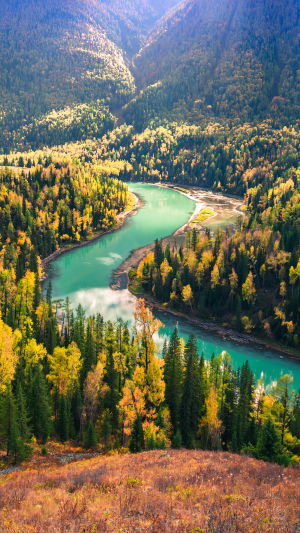Natural rivers are a breathtaking marvel of nature, meandering their way through landscapes with graceful curves and bend.
These meanders, which seem random at first glance, are not arbitrary occurrences. They are the result of intricate processes shaped by a combination of geological, hydrological, and ecological factors. Let’s delve into the fascinating world of meandering rivers to unravel the secrets behind their bends and explore the significance of these dynamic waterways.
Formation and Geological Factors:
The formation of river bends begins with the underlying geology. As a river flows downstream, it encounters different types of rock and sediment, each with varying degrees of resistance. In areas where the river encounters more resistant rock formations, such as granite or limestone, it erodes the surrounding softer sediment at a slower pace. This imbalance in erosion leads to the creation of river bends.
Additionally, external factors like tectonic activity, faults, and folds in the Earth's crust can influence the direction and extent of river bending. These geologic structures can impede or divert the flow of water, forcing the river to adapt its course accordingly, resulting in meandering patterns.
Hydrodynamic Forces and Erosion:
Hydrodynamic forces play a significant role in shaping the curves of natural rivers. The velocity of water is not uniform across the channel; it is highest near the outer banks of the river bend and slower near the inner banks. This variation in speed generates a pressure gradient, with increased erosion occurring on the outer banks due to the higher flow rate.
The erosive power of the river is concentrated on the outer banks, leading to the lateral migration of the bend. As the outer bank erodes, the river widens its path, creating a gentle curve. The eroded sediment is then transported downstream, eventually depositing on the inner bank of the bend, resulting in the formation of a point dam.
Ecological Impact and River Dynamics:
Meandering rivers provide valuable habitats for a diverse range of plant and animal species. The variation in flow velocity and channel morphology creates distinct microenvironments, fostering unique ecological niches. The slower-moving water near the inner banks facilitates the deposition of fine sediment, supporting the growth of vegetation that thrives in such conditions. These vegetated areas provide shelter, breeding grounds, and food sources for numerous aquatic and terrestrial organisms.
River bends also play a vital role in maintaining the health and resilience of riverine ecosystems. They contribute to floodplain connectivity, allowing floodwaters to spread out, and reducing the impact of floods on adjacent regions. The complex interaction between water and land within meandering rivers also aids in nutrient cycling and sediment transport, influencing the overall productivity of the ecosystem.
Natural rivers are an awe-inspiring result of the intricate interplay between geological, hydrological, and ecological processes. The bends and curves found in meandering rivers are not mere accidents; they are a testament to the dynamic forces at work in shaping our planet's landscapes.
Understanding the formation and significance of natural river bends is crucial for a holistic comprehension of river ecosystems and their surrounding environments. By appreciating the delicate balance of nature's forces, we can better manage and preserve these meandering marvels, ensuring the longevity of their ecological importance and the beauty they bring to our world.





